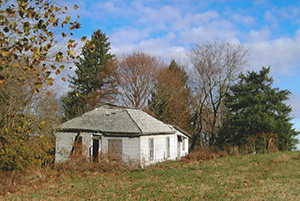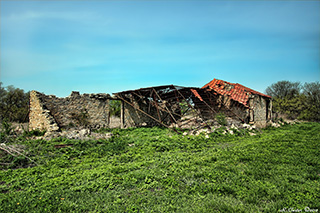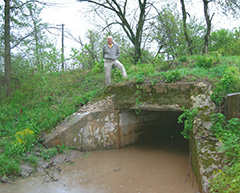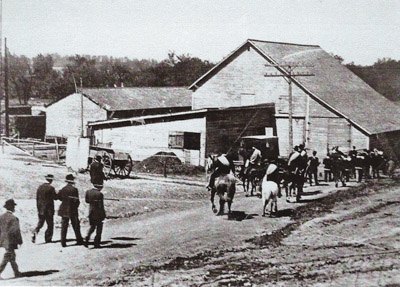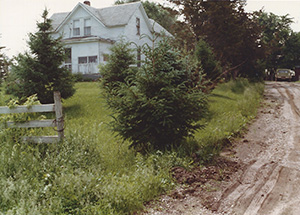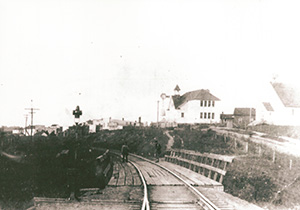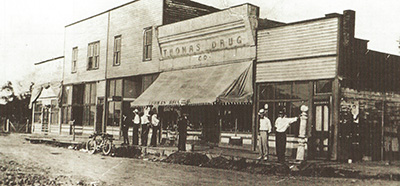
http://www.buxtoniowa.com • Consol, Haydock & Buxton Iowa, USA • 1871 - 2014
Buxton Iowa's 1918 Railroad Viaduct
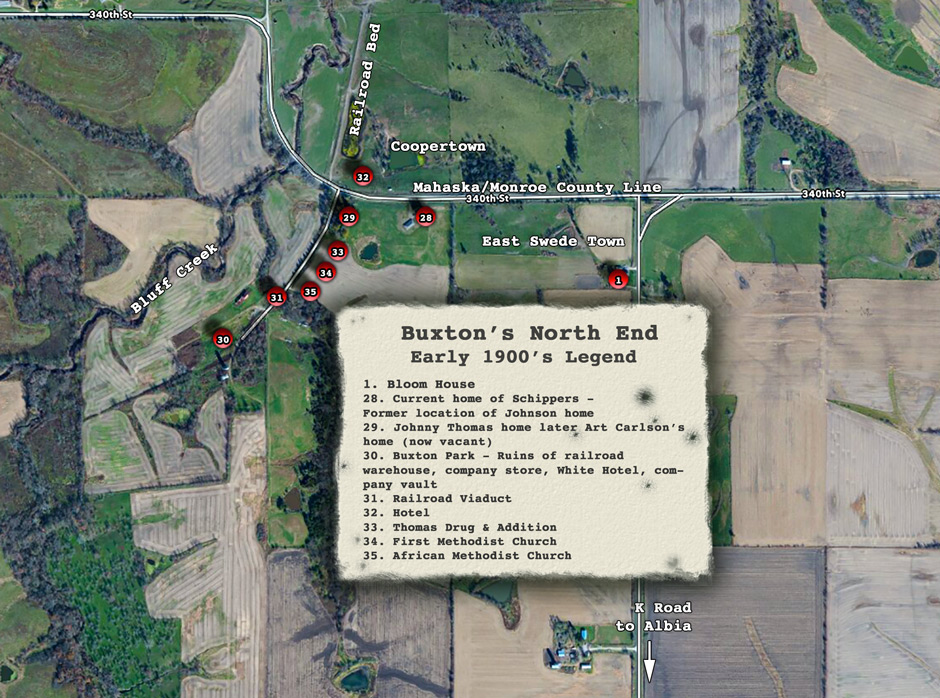
"Buxton's 1918 Railroad Viaduct" by Gordon Peterson
The Albia Union-Republican Thursday July 24, 2014
The 1918 date engraved on the cement facing of the railroad viaduct that during the coal mining era of the early 1900’s carried coal trains north out of Buxton towards Coopertown and Gainestown and south towards the Consol coal fields has all but disappeared. The weather over the decades has caused the date to crumble from the face of the viaduct. The 1918 date has crumbled just as the railroad warehouse that sits only a few yards from the viaduct has crumbled to the ground. The 1918 concrete viaduct replaced a wooden structure that was used from 1900 to 1918.
I would have observed the 1918 viaduct and the date on the facing as far back as the late 1940s when my grandparents, Dave and Emma Peterson (Nylander), lived in the Johnson house prior to buying the nearby Bloom house (current home of Mark and Lisa Keeton) in 1947. The Johnson house sat just up the hill from what now remains of Art Carlson’s home along the Mahaska/Monroe County Line.
It was during that time I would have first started exploring Buxton with my grandmother. I can remember as a young lad walking with her from the Johnson house, down the lane past the Carlson house, past where the First Methodist Church and the African Methodist Episcopal Church (St. John’s) once sat, as well as past where the Thomas Drug Store and addition were located. This was the north entrance to Buxton and paralleled Bluff Creek and the railroad tracks. My grandmother and I would have walked past, if not over, that very “1918 viaduct” as she first introduced me to what would become my lifetime passion of exploring the coal mining camps that once were home to thousands of miners, including my dad’s family.
Now, nearly 70 years later, when I return to continue my exploring and touring of those coal camps of Buxton, East Swedetown, Coopertown, Consol, Bucknell and Haydock, I make it a point to stand on that viaduct so when I look down the remains of the old railroad beds both north and south I can reflect on what life was like in those coal mining camps of 100 years ago. There is something emblematic about standing on a small viaduct that a century ago carried large train locomotives hauling tons of coal to be consumed in coal firing steam engine trains for the Chicago Northwestern Railroad.
The date of 1918 has special significance in the history of coal mining in Monroe County, or for that matter Iowa. In 1918 Iowa ranked as one of the top producers of coal in the nation. With Iowa once being a prominent producer of coal, it is amazing to me that when people discover Iowa was once a major coal mining state it surprises most everyone. Very little coal is mined in Iowa at the present time because of the impurities and high sulfur content of the coal. In my studies of coal mining in Iowa and specifically Monroe County, 1918 seems to be the peak year for the Coal Dust Era in Iowa and Monroe County. Buxton was starting to become a ghost town as was the case of Muchakinock that was south of Oskaloosa two decades prior in 1900. Mines 16 and 17 in the Buxton coal fields were closed and coal mining had moved 20 miles southwest to the Consol coal fields and mines 18 and 19. Many of the miners, especially those who were black, continued to live in Buxton and took a passenger train daily to mines 18 and 19, which were near the coal mining camps of Consol, Bucknell and Haydock. Mine 18 became the granddaddy of coal mines as it was the largest mine in Iowa with production reaching as high as 5,000 tons per day. Mine 18 was located half way between Consol and Bucknell, a distance of two miles. Mine 18’s smokestack was 155 feet tall which made it king of the coal mines. Coal was used to fire the steam turbines that generated DC electrical current to lift the coal up the 150-250 foot deep mine shafts. Mine 18 also supplied all the DC electrical current one mile to mine 19 and is the reason pictures of mine 19 don’t have the proverbial smokestack.
In the early 1920s there were many mixed signals about the future of coal mining in Monroe County. In 1921 the Consolidation Coal Company announced that the shaft of mine 20 would be sank and executives would establish corporate headquarters near mine 20. Mine 20 would be located in what became known as Haydock and was located in Wayne Township. The fact my grandparents built a permanent brick home in Haydock certainly attests to how confident they were for the future of coal mining in Monroe County. The ruins of that home remain standing at the intersection of 160th St.(H32) and 527th Ave. However, after Consolidation ceased supplying Iowa coal to the Chicago Northwestern Railroad in 1923 and sold its Iowa mines in 1924 to the Superior Coal Company in Gillespie, Illinois, the die was cast relative to coal mining in Monroe County and Iowa. The Coal Company also stopped providing passenger service from Buxton to mines 18 and 19 in 1923, which sealed the end of Buxton as a coal mining camp.
While Buxton as a coal mining camp would continue to dwindle the “1918 viaduct” in Buxton would continue to carry across it thousands of tons of coal being mined daily in the Consol coal fields, including from the Rex 5 mine. It all but ended when tracks were pulled and mines 18 and 19 were closed in 1927. Only the Rex 5 mine remained open until its tracks were pulled in 1935. The once great coal camp of Buxton was reduced to corn fields when in less than five decades it was being dug up again by archaeologists from Iowa State under a government grant to try to determine what happened to what once was “Utopia” for miners and their families. The Bloom house (Mark and Lisa Keeton’s current home) and the “1918 viaduct” are the only things to survive functionally from the coal dust era, as the viaduct still carries tractors to corn fields and the Keetons have remodeled the Bloom house. They stand as a lasting tribute to the coal dust era of Monroe County.
Writer Gordon Peterson’s information is for the most part from conversations with his immediate family including his grandparents Dave and Emma Peterson (Nylander) who unlike most families “Returned To Buxton” after the mines closed to farm, until their deaths in the late 1950’s, the very land that once was Buxton’s East Swedetown. A Ron Sim’s article in the Spring 1998 issue of C&NW magazine, North Western Lines, was also referenced. Peterson lives in the Minneapolis, Mn. area.
